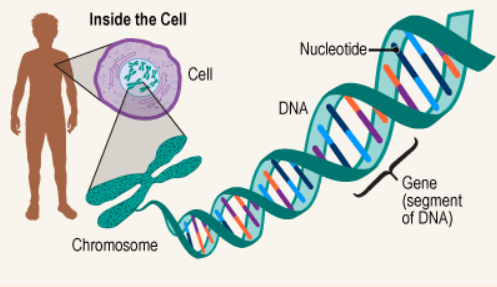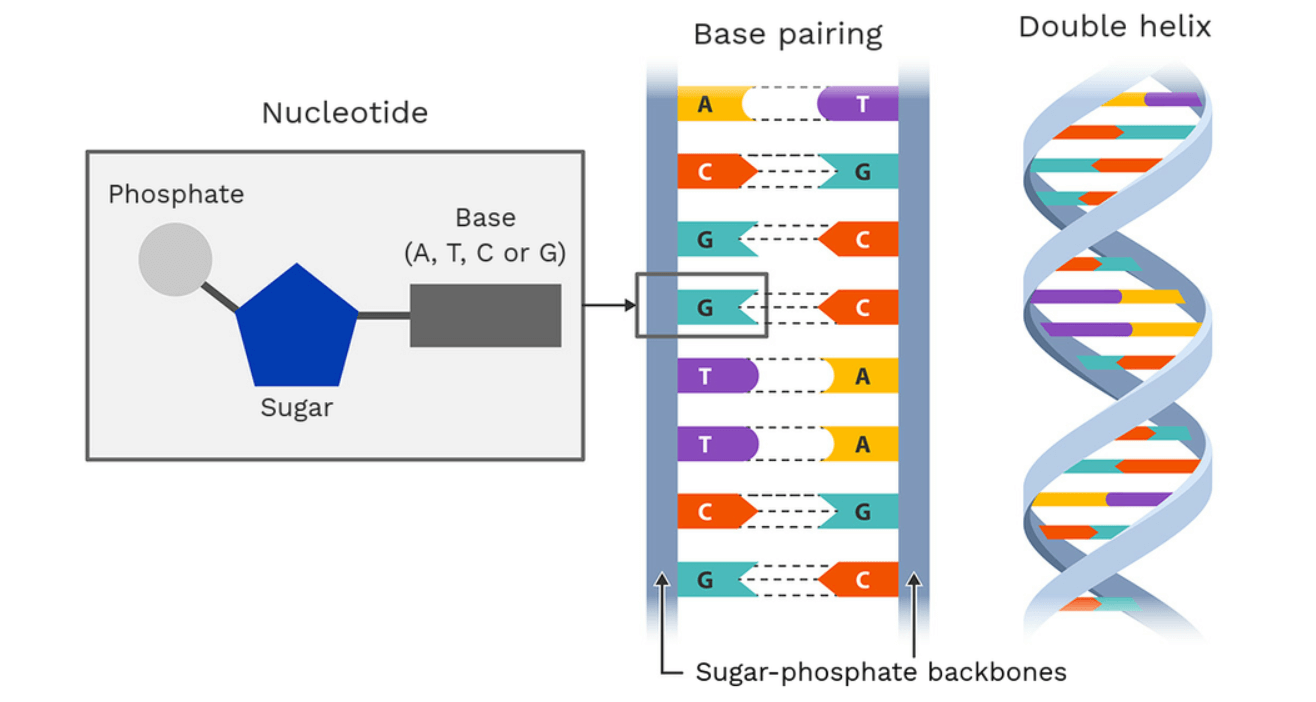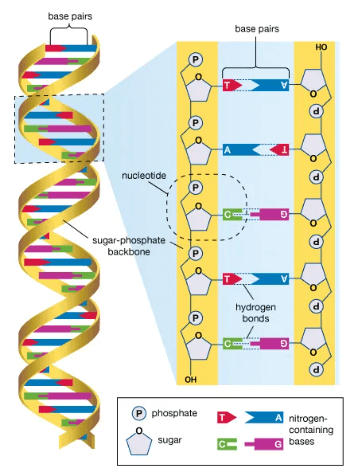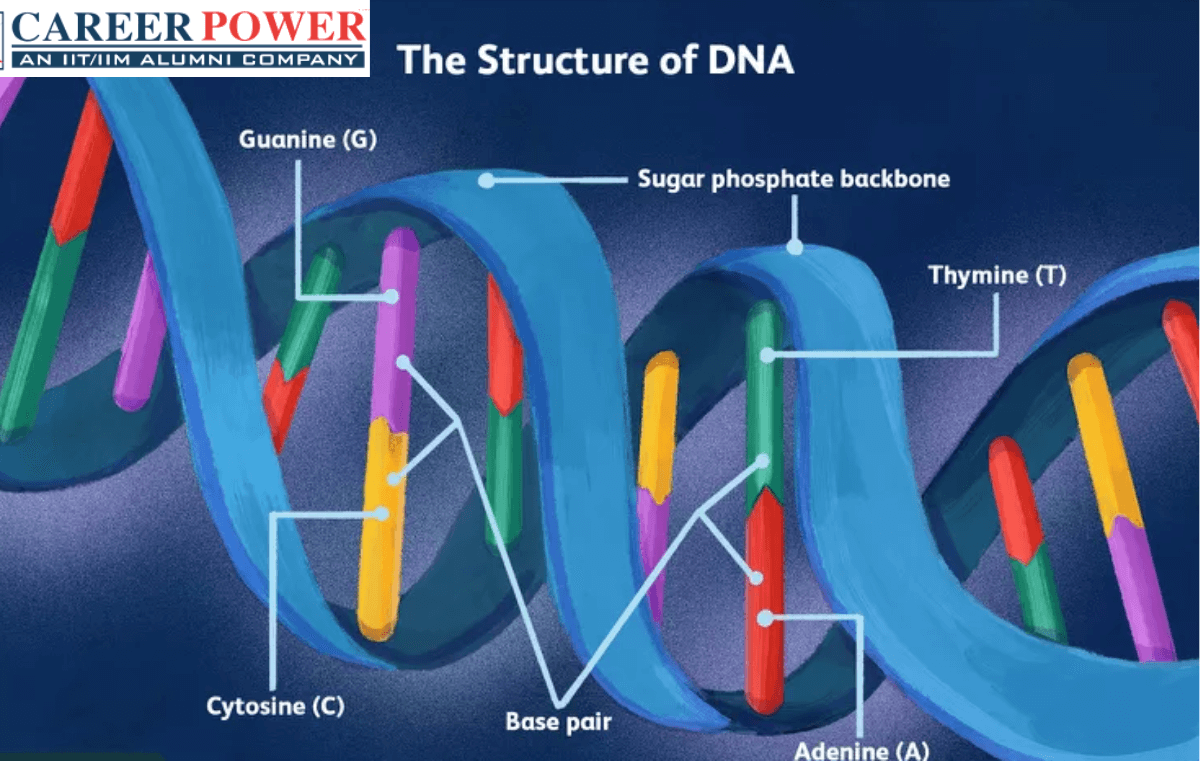As we all know DNA (Deoxyribonucleic Acid) and RNA (Ribonucleic Acid) are two distinct types of nucleic acids found in living organisms, each with its own structure, function, and role in cellular processes. Here we have briefly discussed DNA, its types, functions, and other properties of DNA. The Discovery of DNA involved the work of different scientists over several decades. DNA is a very important topic not just for class 11th or 12th students but also for the NEET 2024 students.
What is DNA?
DNA stands for Deoxyribonucleic Acid, is a molecule found in the cells of living organisms, including humans. It is often referred to as the “genetic code” because it contains the instructions necessary for the growth, development, functioning, and reproduction of all known living organisms. The DNA is found in all the Eukaryotic cells and Prokaryotic Cells.

DNA is a long, double-stranded molecule made up of a sugar (deoxyribose), a phosphate group, and one of four nitrogenous bases: Adenosine (A), Thymine (T), Cytosine (C), and Guanine (G). The unique sequence of these bases along the DNA strand carries the genetic information that determines an organism’s traits, such as its physical characteristics, susceptibility to diseases, and more. The full form of DNA is Deoxyribonucleic Acid.
The double helix structure of DNA was famously discovered by James Watson and Francis Crick in 1953 and plays a crucial role in sorting and replicating genetic information. DNA serves as a template for the synthesis of RNA, which in turn is used to produce proteins and carry out various proteins and carry out various cellular functions. DNA is the foundation of genetics and plays a crucial role in the inheritance of traits from one generation to the next.
Structure of DNA
The structure of DNA is a double helix, which consists of two long chains of nucleotides running in opposite directions and coiled around each other. This double-helical structure of DNA was elucidated by James Watson and Francis Crick in 1953, based on their X-ray crystallography data obtained by Rosalind Franklin and Maurice Wilkin. It’s a fundamental concept in genetics and molecular Biology, as it explains how genetic information is stored, replicated, and passed from one generation to the next. Here’s a simplified breakdown of the structure of DNA:

(a) Nucleotides: DNA is composed of repeating units called nucleotides. Each nucleotide consists of three components:
- A deoxyribose sugar molecule.
- A phosphate group.
- One of four nitrogenous bases: Adenine (A), Thymine (T), Cytosine (C), or Guanine (G).
(b) Base Pairing: The two DNA strands are held together by hydrogen bonds between the nitrogenous bases. Adenine (A) always pairs with Thymine (T), and Cytosine (C) always pairs with Guanine (G). This is known as complementary base pairing.
(c) Double Helix: The two nucleotide chains twist around each other to form a spiral structure, creating a double helix. The sugar-phosphate backbones of the two strands run in opposite directions, which is referred to as an antiparallel.
(d) Base Sequence: The sequence of nitrogenous bases along each strand of DNA carries the instructions for the building and functioning of living organisms.
Discovery of DNA
The discovery of DNA cannot be attributed to a single individual. Instead, the understanding of DNA’s structure and function evolved over several decades through the work of multiple scientists. However, when referring to the discovery of DNA double helix structure, the most famous and celebrated contribution came from James Watson and Francis Crick in 1953.
James Watson, an American biologist, and Francis Crick, a British physicist and biologist, are widely recognized for proposing the double helix structure of DNA. Their breakthrough model, often referred to as the Watson-Crick model, was published in the scientific journal Nature in 1953. Their work built upon earlier research by scientists like Rosalind Franklin and Maurice Wilkins, who provide valuable X-ray crystallography data on DNA’s structure.
DNA Diagram
The diagram of DNA is often represented as a visual depiction of the DNA molecule and conveys several key pieces of information about DNA, such as double helix structure, Base pairing, Directionality, Base sequence, etc. The DNA diagram allows scientists and researchers to understand how DNA stores and conveys genetic information, how it replicates, and how it interacts with other molecules in various biological processes. It serves as a fundamental tool in the study of genetics and molecular biology.

Functions of DNA
DNA serves several vital functions in living organisms. Below we have discussed a few primary functions that collectively make DNA one of the most critical molecules in Biology, as it governs the structure and function of all living organisms and plays a central role in the continuity of life through generations.
- Storage of Genetic Information: DNA stores the genetic instructions necessary for the development, growth, functioning, and Reproduction of an organism. The sequence of nucleotide bases in DNA encodes the genetic code that determines an organism’s traits.
- Replication: DNA can make identical copies of itself through a process called DNA replication. This is essential for cell division and the transmission of genetic information from one generation of cells or organisms to the next.
- Gene Expressing: DNA contains genes, which are special sequences of nucleotides that code for proteins and other molecules. Gene expression involves the process of transcribing DNA into RNA and then translating RNA into proteins. Proteins play a wide range of roles in the body, including enzyme activity, structural support, and regulation of cellular processes.
- Genetic Variation: DNA is subject to mutations, which are changes in the DNA sequence. These mutations can lead to genetic diversity within populations and can be a source of evolutionary change over time.
- Inheritance: DNA is the basis of inheritance. Offspring inherit their DNA from their parents, and the combination of genetic information from both parents determines an individual’s unique genetic makeup.
- Evolution: DNA is central to the process of evolution by natural selection. Mutations in DNA can lead to variations in traits within a population, and advantageous traits may become more prevalent over time through the process of natural selection.
Types of DNA
DNA can exist in different forms and structures, each with specific functions and characteristics. DNA is mainly of three types: A-DNA, B-DNA, and Z-DNA. These are some of the notable types of DNA, each with its own unique structure and functions in various cellular processes and genetic mechanisms. Here are some of the key types of DNA:
| Different Types of DNA | ||
| Types of DNA | Structure/Characteristics | Function/Purpose |
| B-DNA | Right-handed double helix. | Standard DNA structure; carries genetic information. |
| A-DNA | Right-handed, wider, shorter helix (under specific conditions). | Occurs in specific biological contexts. |
| Z-DNA | Left-handed double helix with a zigzag pattern. | The Z-DNA plays a role in gene regulation. |
- B-DNA: This is the most common and well-known form of DNA. The B-DNA is the standard helical structure described earlier, with a right-handed spiral and base pairs that follow the Watson-Crick complementary base pairing rules.
- A-DNA: The A-DNA is a less common form of DNA that occurs under specific conditions, such as dehydration. It has a wider and shorter helical structure compared to B-DNA and is also right-handed. A-DNA can be involved in certain biological processes and is often found in DNA-RNA hybrid molecules.
- Z-DNA: The Z-DNA is a left-handed double helix with a zigzag pattern. It is characterized by alternating purine-pyrimidine base pairs and can form when DNA is under torsional strain or has specific sequences that promote the formation of this structure. Z-DNA is less common than B-DNA and may play a crucial role in gene regulation.
For more details regarding the Difference between DNA and RNA, you can also check our other articles:
Also Read: Difference Between DNA and RNA
Also Read: Difference Between Prokaryotic Cell and Eukaryotic Cell
Also Read: Recombinant DNA Technology



 50 Vegetables Name for Kids in English a...
50 Vegetables Name for Kids in English a...
 Food Chain: Definition, Types, Examples,...
Food Chain: Definition, Types, Examples,...
 Human Respiratory System: Definition, Di...
Human Respiratory System: Definition, Di...













